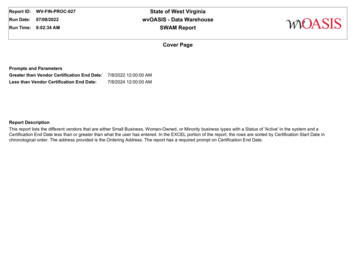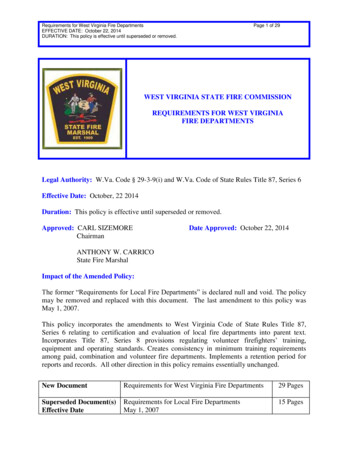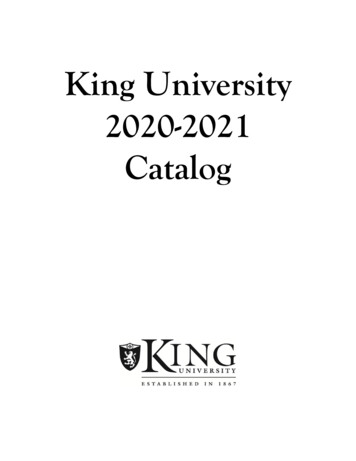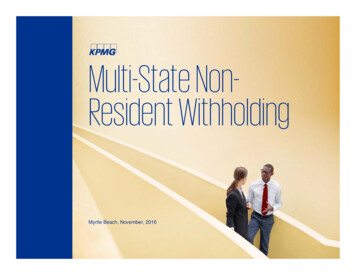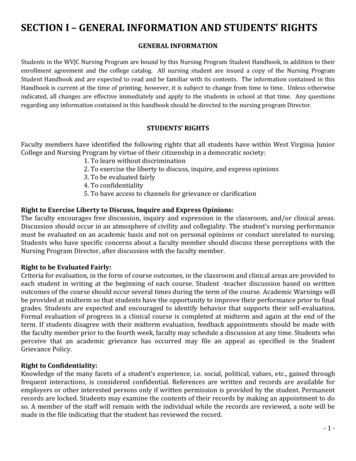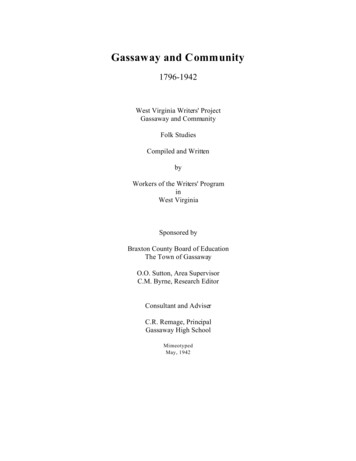
Transcription
Gassaway and Community1796-1942West Virginia Writers' ProjectGassaway and CommunityFolk StudiesCompiled and WrittenbyWorkers of the Writers' PrograminWest VirginiaSponsored byBraxton County Board of EducationThe Town of GassawayO.O. Sutton, Area SupervisorC.M. Byrne, Research EditorConsultant and AdviserC.R. Remage, PrincipalGassaway High SchoolMimeotypedMay, 1942
ContentsIntroduction.3Gassaway.4Timbering in the Gassaway-Rosedale Section .7Gassaway National Guard .7Gassaway Official Roster 1905-1943 . 9The Pioneer Arrives . 12The School House of Yesterday .15Education.15Early Schools.16Buffalo and Coon Creek Schools.16Davis Graded School.17Gassaway High School.18Religion.20First Churches.20Gassaway Churches.21Presbyterian Church . 22St. Thomas Catholic Church . 22Methodist Episcopal Church, South . 23Methodist Episcopal Church . 23Engel Chapel . 24Appendix (Roster of Town Officials and Business Firms).25Chapel Community . 29
IntroductionMost all cities and towns in West Virginia had pioneer surroundings, embracing pioneercommunities in which the dominating force, or power for good, was the school-though primitivein character, and the Christian trail-blazer who proclaimed the gospel tidings and established thefirst church. To these pioneers-strangers to the present generation-we owe much. Our greatnessis built upon the foundation laid by them.Each community in Braxton County had its pioneer settlers, and its first village whichoften grew into a town. The oldest town in the county had its first settlement in 1792; anothervillage settlement in 1793, and another in 1798.The beautiful little city of Gassaway with its schools and churches and varied businessenterprises, had its early community settler in 1796, but the town being born of our progressiveand industrial era did not have its birth until 108 years later, and is the youngest in years and thelargest in population in the county today. And while the town's rapid growth and expansion duein the main to the opportunities offered by this twentieth century tempo, which was responsiblefor its initial influx of population, it must not be forgotten that the descendants of the Gassawaycommunity pioneers-a sturdy, intelligent, independent and God-fearing folk-have been abalancing factor in the life and spirit of this "little city built upon a West Virginia hill."O.O. Sutton
GassawayNestled among a group of hills thrown off from the great Appalachian system, at thejunction of Little Otter Creek and the Elk River, lies Braxton County's largest town-Gassaway.The town was named in honor of Henry Gassaway Davis, a former United States Senator andonce a candidate for Vice-President of the United States, and known to all as West Virginia's"Grand Old Man." It was incorporated as the Town of Gassaway in 1905, at the time of theconstruction of the Coal & Coke Railroad, to the location of whose shops at this point the townowes its rapid growth. It was also the terminus of the Elk and Little Kanawha Railroad, and isconnected with Sutton by a spur off the Coal & Coke.Prior to the year 1903, what is now the site of Gassaway was an old farm, part of a largeboundary of land owned by J.M. Boggs and the Israel J. Friend heirs. The first development ofthis section of the county other than that of agriculture was attempted on a section known as theSalt Works on Little Otter Creek nearly a century ago by the New York Development Company.This company purchased a large tract of land and began prospecting for oil. Oil and gas wereboth found, but in this particular section oil was not found to exist in sufficiently payingquantities but salt was found in abundance.The New York Development Company being unsuccessful in its search for a profitableoil territory, and not desiring to manufacture salt, abandoned the territory and sold its holdings toJ.M. Boggs, who built a salt furnace and manufactured salt for some time. As there was norailroad through the county at that time, and no other transportation facilities except by wagonsover the muddy, dirt roads or in light canoes on the Elk River, his sphere of operations was verylimited. Boggs supplied the territory from Clay Courthouse to Addison in Webster County, andSummersville in Nicholas county. Kanawha salt was then selling at 5.00 per barrel, but Boggsplaced his on the market at 2.00 per barrel or 50ó per bushel, and might have made a great dealof money from the enterprise if he had had transportation facilities to enable him to dispose ofthe entire output of his salt furnace, but he could manufacture in six weeks enough salt to last allthe trade he could reach for two years. At this rate the business was unprofitable; the saltfurnace was closed, and the place lapsed into its former state of an old country farm and soremained until August, 1903.At this time Henry Gassaway Davis having purchased the Charleston, Clendenin andSutton Railroad, and desiring to complete the line from Otter, in Clay county to Elkins, formedthe Gassaway Development Company, and Arthur Lee, Jr., trustee for the new company,purchased eleven hundred acres of land at this point, including parts of two tracts belonging toJ.M. Boggs and a part of the old Friend farm.And near this time the name of the Charleston, Clendenin and Sutton Railroad waschanged to the Coal and Coke Railroad, and Gassaway was located on the route midwaybetween the two terminal points-Charleston and Elkins. The railroad was divided into twodivisions, and since the division running towards Elkins required much heavier engines to haulthe trains through the tunnels and over the hills than did the slightly graded river-route intoCharleston, the ends of the two divisions and the shops were located at Gassaway. (The road isnow owned and operated by the Baltimore and Ohio system.)Having secured the ground and right-of-way for the railroad, the Gassaway DevelopmentCompany in 1904 began to lay out the city, and although Gassaway is a little city set on a hill, itis one of the very few cities that was laid out from the beginning to fit the hill. This work was
done by James A. Paterson, one of the prominent early residents. Paterson surveyed the groundsand made a topographical map of the townsite, and then secured the services of an eminentengineer and the two laid off the town into blocks, streets, and alleys which fit the hills on whichthe town is located. All the preliminary work finished, the summer of 1905 witnessed thebeginning of a new West Virginia town.The first mayor was William Chenoweth; P.M. Dumond, recorder, and W.M. Funk, Dr.A.S. Boggs, and Henry Tuidon, members of the council.The first buildings erected were the Bank of Gassaway, a beautiful native cut-stonestructure whose present officers are Doctor Norman Goad, president, Carl Walker,vice-president, J.B. Fisher, cashier, and Nolan B. Hamric, assistant cashier; the Arthur Leebusiness and office building, at present housing the Gassaway Midland Store company; theJuergens & Walker building; the Davis Grade School, and the railroad shops which occupyseveral acres of bottom land lying between the town and the Elk River. The school building wasused as a place of public worship until 1907, when two churches were built. The new townhowever inherited one church building, a Baptist church which stood on the north side of the Elkjust below the mouth of Little Otter Creek, but this denomination has since built a modernchurch in the town, as have other church denominations.The Armory building was built by James A. Paterson for the accommodation of thecompany of the West Virginia National Guard, located here.The Gassaway Hotel now the Valley Hotel, was built and opened to the public in 1905,and for many years was under the management of A.J. Williams until his death in 1931. Thehotel is known to the traveling public throughout Central West Virginia as a popular "stoppingplace."The latest addition to Gassaway hotels-The Lincoln Hotel-under the management of Mrs.Lillie Brewster is a modern hostelry well-known for its hospitality and home-likeaccommodations.The Boggs Hospital and Sanitarium at Gassaway was completed in May, 1906. Thepromoter and builder of the institution was Dr. A.S. Boggs son of J.M. Boggs. The building is alarge three-story frame structure with basement, and wide veranda encircling the entire firstfloor. The cost of the building was approximately 25,000.In the year 1906, the Gassaway Era was established by John A. Grose of Sutton, and wascontinued for a number of years when it was sold to private individuals of the town whosuccessfully conducted the newspaper for many years. The name of the paper was changed tothe Gassaway Times, which at different periods was edited by William Swann, Perry Layman,Harry Woodley, and A.H. Erhart. The plant was sold and removed to Dunbar a few years ago,thus ending the history of Gassaway's only newspaper.The town in 1909 was enlarged by the Stewart Addition. A plot of land was purchasedand streets and alleys surveyed and lots for home building sites staked out. Dr. G.F. Perry ofFlatwoods installed a planing mill and was active in building up this new addition on the northside of the Elk. A wire suspension foot bridge connected the addition with the main town untilthe present highway bridge was built by the State Road Commission in 1927.The first bridge built across the Elk River leading into the town was constructed in theyears 1912-13, the whole cost of building being borne by the town of Gassaway. This was aniron bridge of two or more spans resting on stone pillars and abutments. This bridge wasreplaced in the year 1935 by a modern steel structure of three spans built by the State RoadCommission.
The railroad company in the years 1914-15 built a handsome and commodious two-storydepot of stone and brick at a cost of 25,000. The town owns a beautiful park of about threeacres which lies adjacent to the Baltimore and Ohio depot. The park is used chiefly as aplayground; also, the new municipal building stands in the east corner of the park.The Gassaway Livestock Market, Inc. was established at Gassaway in recent years.Many of the largest livestock producers and shippers in the county pooled their money andefforts in this important undertaking.The need for a municipal building being apparent, the citizens of the town, on July 12,1938, voted a bond issue of 20,000 (a portion of which was used for street paving purposes),supplemented by 42,000 contributed by the Work Projects Administration. The building-twostories built of native stone, located on Elk Street, houses the following departments: mayor'soffice, council chamber, motorized fire department, public library, and auditorium for combineduse as a recreation center.The location of Gassaway is a beautiful one, surrounded as it is by entrancing mountainscenery. It may be properly termed an agricultural center, serving a large area of fertile andwell-kept farms. Also, a splendid citizenship resides near the town in the Otter Creek and ElkRiver valleys. The surrounding communities have good schools and churches, and many otherorganizations that wield an important cultural influence. The rich farming region that surroundsthe town contributes to its economic welfare. Gassaway is supplied with water by the WestVirginia Water Service Company, whose plant is equipped with modern purification devices.The Monongahela West Penn Public Service Company supplies the town with electric power,and the Hope Natural Gas Company supplies gas. City services include sewerage, six miles ofpaved streets, fire department, police and other features of present-day towns, and a publiclibrary. An active chamber of commerce organized in 1920 is made up of local business menwhose object is to promote the best interests of the town and surrounding community; theofficers are Dr. E.L. Fisher, president, G.C. Byrne, vice-president, Vaughan H. Duffield,secretary, F.H. Grose, treasurer, and Roy B. Cartright, chairman of the program committee.Amusement is provided by the Alpine Theatre. There are two beauty and three barbershops, five garages, six filling stations, five restaurants, two drug stores, hospital service,jeweler, one bank, funeral home, and two hotels. Other needs are supplied by merchants ofvarious kinds. The town is well provided with tourist accommodations and offers attractivepossibilities in this respect; quiet and unhurried, Gassaway is ideal for those who seek completerelaxation, and fishing in the Elk provides a sport for more active vacationers.Three physicians and two dentists practice in Gassaway. Two lawyers serve the legalneeds. A Woman's Club, a public library, an American Legion Post, a chamber of commerce,the Gassaway Elk Chapter-Future Farmers of America, and various church and schoolorganizations provide nuclei for social activities.In the history of Gassaway many names stand out as representative of the civic pride thatbuilt up the town on the Elk to its present importance and beauty. Among these but by no meansa complete list are Henry Gassaway Davis, Arthur Lee, Chas. S. Robb, C.M. Handley, James A.Paterson, Dr. Andrew Boggs, Dr. James A Rusmisell, Dr. Charles Rusmisell, John L. McCoy,J.P. Keeley, W.P. Bartlett, B.S. Hulm, Alex Groves, Henry S. League, Wm. M. Chenoweth, S.C.Rosenberger, A.L. Williams, I.N. Kalbaugh, J.S. Sergent, Dr. John W. Hyer, Mrs. Ida B.Johnston, P.M. Dumond, C.L. Perkins, J.C. Kinton, P.G. Cutlip, David Frame, N. Van Wilson,C. W. Flesher, J.A. Huff, Perry Layman, Harry Woodley, Albert Hostetler, Lloyd Shomo, W.G.Carper, Joseph Daugherty, John Poling, William Paxton, W.M. Funk, H.H. Mollohan, Dr. J.W.
Smith, Scott Duffield, J.H. Beall, J.A. Bridge, Carl Walker, H.L. Gum, C.R. Remage, J.B.Fisher, E.H. Bills, H.C. Isenhart, H.A. Hays, I.F. Harold, John Timms, Thomas Morgan, L.D.Rose, John Cain, John Paisley, Clinton Shaffer, Jacob Scheerer, Henry Cunningham, O.J.Pittman, Henry Bender, J. Lee Simmons, H.C. Duckworth, Dr. C.C. Carson, and Dr. H.L. Welch.Many of these are still serving the community.The 1940 census gives the population as 1,429.Timbering in the Gassaway-Rosedale SectionThe vast quantities of timber in the section between Gassaway and Rosedale caused thebuilding of the Elk and Little Kanawha Railroad from Gassaway to Stumptown which wascompleted in 1913. This was a narrow gauge road and was operated as a private lumber road,but also carried passengers and freight. Timbering in this section was conducted by theInterstate Cooperage Company, a subsidiary of the Standard Oil Company, which purchased andmanufactured chiefly into oil barrel staves a 28,000-acre tract known as the Bennett Heirs' land.This company began the stave industry and had mills on this tract long before the railroad wascompleted. The timber operation was completed in 1920, and the railroad removed. Ahard-surfaced highway now runs over a large part of the old railroad bed.Gassaway National Gu ardGassaway National Guard, Company "G", 150th Infantry: West Virginia National Guardwas organized at Gassaway, May 11, 1928. The officers and personnel consisted of : CaptainDaniel G. Simmons, formally commanding Company A of the 137th machine battalion 38thDivision A.E.F.First Lieutenant, Harry H. Duckworth, formally Air Service A.E.F.Second Lieutenant, George Coble Byrne, formally Machine Gun Service A.E.F.The non-commissioned officers consist of the following:First Sergeant, Harry E. Havermill.Supply Sergeant, Austin D. DuckworthMess Sergeant, Oscar E. FanslerSergeants, Clyde G. Sands, Olen Weaver, Everett O. McMorrow, Earl McCune, HenryA. Nussear.Corporals, Wayland F. Keener, Walter L. James, Joseph E. James, Ray W. Northcraft,Luther L. Hayhurst, Joseph T. Conley, Albert Carr.Company Clerk, Robert M. Heflin.Privates First Class, James A. Boggs, Oscar C. Drake, Edwin E. Duckworth, James D.Duffield, Robert H. Hays, Roy Hamric, Jas. M. Hefner, Ralph K. Keener, Spurgie A. Mace,Elmer L. Mullens, Amos H. Riffle, Charles J. Riffle, Paul A. Russell, Rowland G. Samples,James R. Sergent, Jr., John W. Smith.
Privates, Clarence O. Boggs, Ralph W. Bills, Clarence Bennett, Leonard A. Burns,Francis O. Burkhammer, Robert L. Corkett, Gus H. Caldwell, Chelsea A. Couger, Waine H.Chamberlain, Glenn H. Fowler, Carl O. Hughes, John W. Hannah, Chelser A. James, Roy L.James, Farrell D. James, Bertie G. Keener, James H. Lough, Leslie E. Lancaster, Ernest T. Lytle,Ivan F. McElwaine, French C. McTheney, Murville L. Moore, Frank M. Otto, Herman B.Stewart, Amos E. Starcher, Paul Smith, Brown E. Singleton, Lloyd I. Twyman, ClarenceTrowbridge, Cleo O. Teets, Rupert E. Vanhorn, Thomas J. Williams.
Gassaway Official Roster1905-19431905-1906W.M. Chenoweth, Mayor; P.M. Dumond, Recorder, and W. P. Bartlett, Dr. A.S. Boggs,Wade Osborne, Charles Lewis, R.A. Hall, Councilmen.1906-1907W.M. Funk, Mayor; John A. Huff, Recorder, and W.F. Osborne, W.P. Bartlett, HarrySnyder, Albert Funk, John M. McCoy, Councilmen.1907-1908P.H. Murphy, Mayor; C.L. Perkins, Recorder, and Dr. A.S. Boggs, J.J. Shannon, W.F.Osborne, Alex Groves, J.F. Moore, Councilmen.1908-1909P.H. Murphy, Mayor; C.L. Perkins, Recorder, and O.J. Pittman, D.W. Howell, C.J.Scheerer, H.S. League, R.E. Floyd, Councilmen.1909-1910C.L. Perkins, Mayor; G.A. Moon, Recorder, and J.P. Keeley, C.J. Scheerer, J.N. Poland,W.F. Osborne, H.C. Isenhart, Councilmen.1910-1911H.C. Isenhart, Mayor; H.A. Hays, Recorder, and C.B. Shreve, H.E. Woodley, J.P.Frame, J.P. Keeley, C.N. Kalbaugh, Councilmen.1911-1912W.M. Funk, Mayor; C.L. Heater, Recorder, and W.P. Bartlett, M.C. Watkins, J.M. Cain,W. H. Hiser, W.F. Osborne, Councilmen.1912-1913O.J. Pittman, Mayor; O.P. Frame, Recorder, and C.S. Haymond, H.C. Isenhart, H.H.Mollohan, B. H. Griffin, W.F. Henretta, Councilmen.1913-1914H.A. Hays, Mayor; J.W. Zarling, Recorder, and C.O. Byrd, J.H. Friend, E.C. Jones, J.S.Nicola, G.C. Belknap, Councilmen.1914-1915E.C. Jones, Mayor; C.R. Applegate, Recorder, and J.L. Barker, R.L. Sponaugle, J.M.Blackwood, S.C. Johnson, J.A. Huff, Councilmen.
1915-1916S.C. Johnson, Mayor; O.V. Wilson, Recorder, and J.N. Blackwood, H.B. Mollohan, J.H.Beall, Thomas Browning, R.L. Sponaugle, Councilmen.1916-1917H.H. Wilson, Mayor; O.V. Wilson, Recorder, and J.H. Beall, R.L. Sponaugle, R.M.Houston, M.J. White, Chas. R. Summers, Councilmen.1917-1918O.P. Frame, Mayor; C.L. Heater, Recorder, and W.P. Bartlett, A. Hostetler, James J.Frame, A. Kibbie, C.C. Rusmisell, Councilmen.1918-1919C. L. Heater, Mayor; R. Lee Boone, Recorder, and H.H. Huff, J.P. Frame, L.A. Jarrette,L.R. Shomo, John H. Beall, Councilmen.1919-1920R.L. Boone, Mayor; H.L. Gum, Recorder, and J.B. Fisher, John H. Beall, O.J. Meadows,C. C. Rusmisell, H.C. Isenhart, Councilmen.1920-1921S.C. Johnson, Mayor; H.L. Gum, Recorder, and H.B. Mollohan, Frank Sutton, C.E.Walker, C.L. Heater, James R. Riffle, Councilmen.1921-1922G.C. Belknap, Mayor; Mrs. E.L. McCrey, Recorder, and O.P. Frame, H.A. Fast, B.M.Shears, J.J. Timms, B.W. Piercey, Councilmen.1922-1923G.C. Belknap, Mayor; Luther Wood, Recorder, and J.J. Timms, J.D. Calfee, R.L.Sponaugle, O.P. Frame, J.W. Colliver, Councilmen.1923-1924Luther Wood, Mayor; J. Lee Simmons, Recorder, and U.F. Duffield, O.P. Frame, J.D.Calfee, A.H. Young, E.M. Layman, Councilmen.1924-1925C.L. Perkins, Mayor; J.L. Simmons, Recorder, and H.L. Gum, H.T. West, O.P. Frame,J.J. Timms, C.H. Bills, Councilmen.1925-1926C.L. Perkins, Mayor; Sam Fox, Recorder, and Oscar Duncan, Lawrence Bowen, J.J.Timms, B.W. Piercy, H.L. Gum, Councilmen.
1926-1927C.L. Perkins, Mayor; H.L. Gum, Recorder, and H.F. Remaley, J.C. Kinton, H.C.Isenhart, S.W. Rosenberger, L.E. Bowen, Councilmen.1927-1928C.L. Perkins, Mayor; C.L. Heater, Recorder, and H.C. Isenhart, S.O. Buzzerd, R.L.Sponaugle, A.C. Calfee, U.F. Duffield, Councilmen.1928-1929C.L. Heater, Mayor; J.L. Simmons, Recorder, and U.F. Duffield, L.E. Bowen, C.H.Bills, D.H. Baker, H.B. Mollohan, Councilmen.1929-1930C.L. Heater, Mayor; C.L. Perkins, Recorder, and H.B. Mollohan, C.H. Bills, U.F.Duffield, D.H. Baker, L.E. Bowen, Councilmen.1930-1933C.L. Heater, Mayor; C.R. Walker, Recorder, and J.W. Colliver, Gay Rusmisell, C.S.Haymond, H.S. Sergent, E.F. West, Councilmen.1933-1935J.J. Timms, Mayor; W.W. Hymes, Recorder, and C.S. Haymond, H.E. Bragg, S.L. Cole,P.H. Friend, O.E. Powelson, Councilmen.1935-1937J.A. Bridge, Mayor; C.C. Ballengee, Recorder, and D.G. Simmons, Guy L. Warner, J.E.Conley, Carl McCune, N.B. Hamric, Councilmen.1937-1939J.A. Bridge, Mayor; Lloyd M. Bartlett, Recorder, and D.G. Simmons, Guy L. Warner,J.E. Conley, H.B. Mullens, Carl McCune, Councilmen.1939-1941J.A. Bridge, Mayor; Lloyd M. Bartlett, Recorder, and D.G. Simmons, Guy L. Warner,J.E. Conley, Carl McCune, H.B. Mullens, Councilmen.1941-1943J.A. Bridge, Mayor; Karl Skidmore, Recorder, and Carl Duckworth, Ira Gum, CarlMcCune, S.L. Cole, A.T. Helmick, Councilmen.
The Pioneer Arrives"Undaunted by danger, unconquered, true-hearted,With ax-beaten march the brave pioneers came,And the wild tangled vine of the wilderness partedAs progress swept onward with banners of flame."The story of the exploration, settlement and development of the trans-Appalachian regionconstitutes one of the most fascinating chapters of American history. The territory includedWest Virginia, which received a few white settlers in its eastern panhandle as early as 1726-27.Its plain but self-reliant pioneers were the fore-runners of a mighty tide of immigration,far greater in energy than in numbers, which burst the barriers of the Alleghenies. Theyparticipated in the Anglo-French struggle for a continent-a struggle which began by strifesbetween frontiersmen of rival nations along the upper Ohio. At the close of that struggle, fromwhich they emerged with a new stimulus born of victory, they advanced from ease and securityof older settlements into the trans-Allegheny wilds, steadily pushed back the frontier and theIndians, and in the heart of the wilderness established their homes on many streams whose fatehad recently hung in the balance. Here, they turned to the conquest and subjugation of theprimeval forest which the Indians had sought to retain unconquered.The story of the settlement of every early community is full of the heroic deeds of theseplain, modest, uncelebrated men of the struggling common people-men who sought no praiseand achieved no great fame, who were not conscious of their own greatness, but who werealways ready for any service which was needed to maintain an advancing frontier. Out of manysprings among the hills emerged at last the irresistible current of their strength. They toiled notin vain. While building homes in the wilderness they were raising the framework of aself-governing state destined to play an important part in the history of the nation.Into the forest-clothed land came settlers seeking new homes; here each pioneer clearingbroadened into a field in which all that was worthy of human endeavor found a fertile soil togrow, and on the spot erected a log cabin. Pioneers were beginning to find their way into thebeautiful Elk River valley.Among the first to come was a man by the name of Cottrill from Virginia, who settled inthe year 1796 on the Elk River at the mouth of Little Otter Creek opposite Gassaway, and theFriend Family, consisting of three brothers Andrew P., Israel J., and Thomas came to BraxtonCounty from Pendleton County in 1807, and also settled on the Elk at the mouth of Little Otter.They were of German descent. Early in the nineteenth century Andrew P. Friend built the firstgristmill at a point on the Elk River, since locally known as Beall's Mill. The site of the town ofGassaway was owned at one time by Israel J. Friend and James A. Boggs. This site seemed tohave been a favorite resort for the Indians as many Indian relics have been found. There was atone time a celebrated salt spring at the mouth of Little Otter Creek and the Indians doubtlessresorted here for the purpose of making salt.The Frame family-James, Thomas, and David-settled on the Elk in 1808; this familycame from Pocahontas County in the year 1801 and first settled on the Big Birch River at the
mouth of Powell's Creek. David Frame built his cabin home three miles above Gassaway. Anearly school was taught by him at Sugar Bottom on the Elk River, a short distance below theresidence of Archibald Taylor. Today the Frame family is a numerous one; many descendantsof this well known family reside near the present site of the town of Gassaway; and in the year1810 Jacob Long and Charles Rogers came from Pocahontas County. Long settled on the northside of the Elk opposite Little Buffalo Creek, and Rogers settled on Little Otter Creek (a sonBallard S. Rogers was a Confederate soldier in the War Between the States).Among the earliest pioneers coming from the Virginia settlements were the Skidmores,one of whom, Andrew was born in 1780, settled in the year 1814, on the Elk River three milesabove Gassaway on a tract of 140 acres of land purchased from John D. Sutton and paid forprincipally by labor in building a post and rail fence on the bottom where the town of Suttonstands.Francis B. Stewart, an early community settler, was born near Skidmore's mill on the ElkRiver in 1818, was a carpenter and boat builder. He built over 300 rafts and boats, and floatedmuch timber to Charleston at an early period. The grandfather of Francis B. Stewart was aRevolutionary soldier and served as a bodyguard of General Washington at the time of thesurrender of Lord Cornwallis at Yorktown, October, 1781, and also served as a soldier in theWar of 1812 (one son James M. Stewart was a Union soldier, member of Company F, 10th WestVirginia Infantry); Jonathan C. Friend came to Braxton from the state of Maryland in 1822, andsettled near the site of Gassaway (one son Jonathan Caldwell Friend was a minister of thegospel).Archibald Taylor came to the Elk around 1822 from Champaign County, Ohio, where hewas born October 27, 1795. Two years later he married Elizabeth Friend, daughter of Thomas,and established his home in 1834 on a 1,000-acre tract of land 3 miles from Gassaway (one sonGustavus Taylor was a member of the Constitutional Convention held at Wheeling in 1861-62,was prosecuting attorney of Braxton County in 1870, and was one of the first editors of TheMountaineer, Sutton's first newspaper.One name which seems prominently linked with that of the early settlement of thecommunity is that of James Anderson Boggs, born in 1815, in Lewis County and came toBraxton County in 1834. He married Susanna Cutlip of Braxton County and to this union wereborn eleven children. He represented Braxton County in the state legislature in 1882-83; hisreal estate holdings extended from Braxton County into the counties of Clay, Roane, andWebster (one son Peyton J. Boggs was a Confederate soldier, serving in Company I, 3rd VirginiaCavalry. He engaged in farming and sawmilling on Sugar Creek); Francis C. Boggs whoresided near Gassaway, was elected sheriff of Braxton County in 1860 for a period of two years;he was the last sheriff of the county under Virginia jurisdiction; Isaac Rose born nearChambersburg, Pennsylvania in 1769 where he grew to manhood, move to Botetourt County,Virginia in 1794, thence to Nicholas County in 1805 and to Braxton County, 1836 (one sonEzekiel Rose settled on the Elk waters below Gassaway, and two of his sons Marshall andFielding were ministers of the gospel, also Fielding was a Confederate soldier, and two othersons James and Mortimer
company of the West Virginia National Guard, located here. The Gassaway Hotel now the Valley Hotel, was built and opened to the public in 1905, and for many years was under the management of A.J. Williams until his death in 1931. The hotel is known to the traveling public throughout Central West Virginia as a popular "stopping place."


